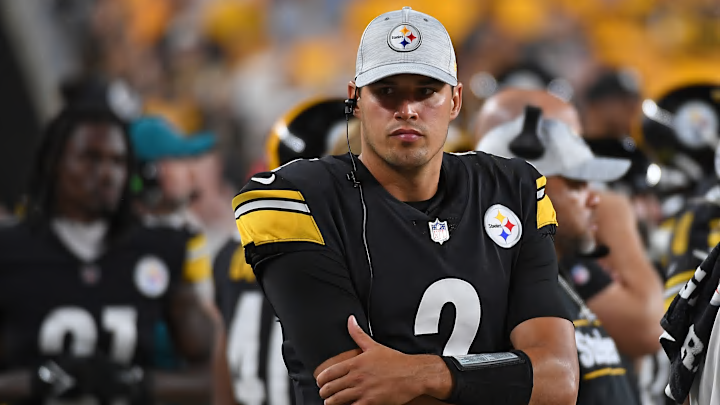The fallout from George Pickens’ trade to the Dallas Cowboys has left the Pittsburgh Steelers in a familiar position. Pickens can be frustrating, but his talent is tremendous. However, in a division where rivals like the Baltimore Ravens and Cincinnati Bengals are amassing talent around their elite quarterbacks with dynamic, high-octane offenses, Pittsburgh has chosen to model itself after a professionally repackaged version of Iowa football.
At a lower level, Iowa’s disposition in the Big Ten ecosystem is equivalent to Pittsburgh’s standing in the AFC North hierarchy. Ohio State, Michigan, and now Oregon tend to do it out for playoff seating, while Iowa is content with winning eight games with a no-frills offense. Both Kirk Ferentz and Tomlin are the longest-tenured head coaches at their respective levels, despite fielding excruciatingly conservative offensive systems.
Even the Cleveland Browns have mortgaged future draft capital in the name of quarterback stability and playmaker acquisition. Pittsburgh, on the other hand, has leaned into trench warfare and unwavering loyalty to sepia-toned football.
In 2023, the Hawkeyes won 10 games with the nation’s 130th-ranked offense and Tomlin put them on his vision board. The Hawkeyes went 8-5 on the backs of a passing attack which produced 10 touchdowns through the air in 2024. Anything Ferentz can do, Tomlin can do better.
The Pittsburgh Steelers have to set their sights higher
In recent years, Pittsburgh’s draft strategy in 2024 has resembled an Iowa alumni newsletter. Defensive lineman Logan Lee, fullback Monte Pottebaum, defensive tackle Yahya Black, and safety Sebastian Castro all found their way to the Steel City via draft or undrafted signings. Last April, Pittsburgh drafted Lee to add depth to their defensive line. They signed Iowa fullback Monte Pottebaum to the 53-man roster until he hung up his cleats during training camp.
In the third-round, Pittsburgh selected downhiller bruiser Johnson, who ran a 4.57 40 at the NFL Combine, but won Big Ten Offensive Player of the Year in a zone running scheme similar to Arthur Smith’s. Tomlin’s affinity for Iowa pro prospects is as strong as his devotion to gritty. He’s not a flashy prospect. Johnson ran a 4.57 40 at the combine, but at least they know what he looks like clad in black and yellow. Tomlin’s affinity for Iowa prospects led him to draft Black, another Iowa defensive lineman in the fifth round. After the draft, he made a beeline for Castro.
Though the Steelers traded for DK Metcalf, a dynamic No. 1 wideout, they have failed to pair him with a reliable quarterback or a secondary receiving threat. Russell Wilson and Justin Fields both chose to leave for New York. Sam Darnold reportedly preferred Seattle. Aaron Rodgers hasn’t returned their calls. Meanwhile, Pittsburgh ignored Jaxson Dart in the first round and passed on Shedeur Sanders in the fourth, opting for rotational defensive linemen over a high-upside quarterback.
Despite beginning free agency with a barren quarterback room, and a plethora of quarterback options at their disposal, plus at least one big play receiver, they came up empty. Whereas other franchises gamble on the potential of dynamic offenses, Pittsburgh hoards defensive line talent like they’re canned goods before a hurricane. While the vast majority of Steeler nation was fretting over their tepid, passing attack, the 300 rushing yards they surrendered to the Ravens in their playoff loss has been eating Tomlin up. That might win in the regular season, but it rarely delivers Lombardis in the modern NFL.
After spending all last season with one No. 2 receiver to pair with Wilson, the Steelers are on track to begin off-season training camps without a viable starting quarterback, and no second target for Mason Rudolph.
Tomlin and Omar Khan’s apathy for obtaining or developing a franchise quarterback is clear as day. The Steelers have been a bottom-10 passing attack since Ben Roethlisberger retired. They're on pace to continue that trend in 2025.
There is still a real possibility Pittsburgh unloads picks from the coffers to acquire a reliable perimeter target. However, they still lack a true starter and Smith’s years in Atlanta were marked by an allergy to quarterback development. In Atlanta, he was content to pass on Fields, to self-mollify alongside Marcus Mariota and Desmond Ridder behind center.
Tomlin and Smith seem content to ride or die, with a stagnant offense sputtering along at 45 mph on the freeway Ferentz has been passenger seat driving Iowa’s offense with the keen (hawk’s)eye of a driver's ed instructor for decades now. In one sense, it makes a modicum of sense. Few expect him to win in the Big Ten or attract elite top recruits to Iowa City. As long as they keep things respectable, the people are content.
The steel-town values of toughness, modesty, and blue-collar work ethic remain alive and well. But that nostalgia costs wins in January. Rather than addressing the imbalance through bold offensive moves, the Steelers retreated further into their conservative bunker.
Perhaps Tomlin has gotten too comfortable to understand the urgency of now. However, the Steelers are a franchise that has earned six world titles and there’s no excuse to be modeling themselves after the dullest college football program in America.
